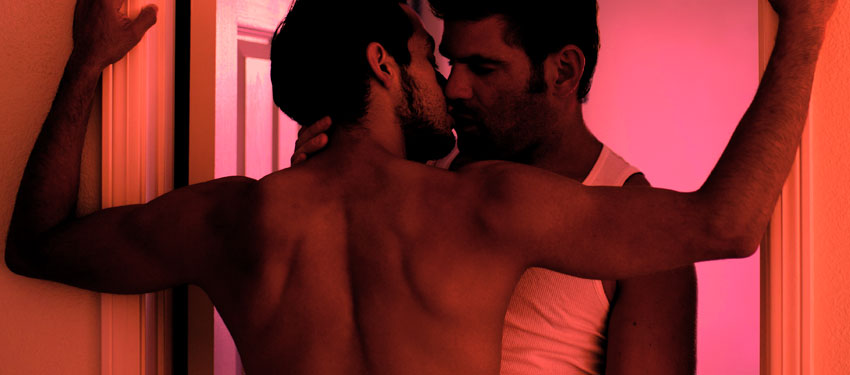
Writing for the other team

A normal Sunday afternoon, with sex toys
ON a Sunday afternoon in a small meeting room in a Melbourne CBD hotel, a group of people, mostly women, most of them straight, gathered to learn how to use sex toys in gay sex.
The assortment of around 10 participants were writers and editors of romantic and erotic fiction. They sat in a circle of chairs around the room, while at the front of the room, laid out on a trestle table, was an array of vibrators, dildos, butt plugs, anal beads and a whole host of other things a person could plug into either the wall or an orifice.
At the beginning of the hour-long session, facilitator Louise Bourchier asked everyone sitting around the circle what they hoped to learn.
One author responded: “I want to expand my knowledge of things I can use as plot devices — or just devices — in my fiction.”
The others in the circle gave similar answers: they were there to find out how to make the sex scenes depicted in their fiction more interesting, and importantly, more accurate and realistic.
The session was running as part of a new festival called Queermance. Billed as “a celebration of GLBT relationships in fiction”, the two-day festival, in its inaugural year, invited writers and readers of queer-focused romantic fiction to participate in workshops on everything from writing sex and relationships to getting published.
Even nestled within a diverse program, the workshop Sex Toys with D.Vice stood out. Bourchier works at D.Vice, a women-owned sex toy shop in Melbourne specialising in adventurous equipment and actively encouraging sex positivity in the broader community.
Following her introduction, every device on the table at the front of the room was passed around the circle. An assortment of colourful shapes, most of them buzzing and pulsing, were handed from one attendee to the next, as Bourchier explained the ins and outs of their ins and outs.
When it came to one particular item — a small, vibrating black bullet called a Salsa — Bourchier highlighted one of the pitfalls of writing sex toys: not everything was waterproof.
“If you’re doing a wet water play scene, ‘She grabbed her Salsa’ is an appropriate line,” Bourchier said, explaining how the toy, unlike many, could be used in the bath.
Although attendees struggled to go 30 seconds without someone exploding into fits of giggling, people frequently remarked on how they might incorporate this or that toy into a story they were writing.
“You can also use them for vibrating against the perineum on guys, and that can cause forced orgasms,” one author piped up while a particular toy was doing the rounds, adding by way of explanation: “I’ve got a sadist as a character.”
Giggling along with the rest of them was Matthew Lang, the festival organiser. He is himself an author, writing fantasy novels with a strong element of queer romance. Putting together the festival program he realised there was a need for some basic explanatory information about queer and kinky sex. There were two simple reasons for this.
The first was the phenomenal success of Fifty Shades of Grey, the erotic romance novel by British author E. L. James, credited with bringing BDSM (bondage and discipline, dominance and submission, sadism and masochism) into the mainstream.
The book was a frequent topic of conversation at the sex toy workshop, but usually as the subject of derision by the authors present. If they weren’t judging James’ purple prose they were criticising her apparent lack of actual BDSM knowledge. As Lang argued later, much of the Fifty Shades of Grey-bashing within the romantic and erotic fiction community was based on the thought that everyone wished they had written it. Or at least a better version of it.
The second reason Lang included the workshop was more unexpected: The vast majority of gay male romantic and erotic fiction is written by and for heterosexual women.
The result was the unusual but highly-entertaining and informative sex toy workshop — a room full of straight women being taught about kinky gay sex so they could write about it more accurately for their generally straight, female readers.
Given its success, Lang hoped to expand this aspect of the program, and also hoped to work with gay adult store Eagle Leather at incorporating classes on BDSM topics into the festival next year.
· · · · · · · · · ·
A brief history of fictional characters having sex
QUEERMANCE grew out of the enormous success of similar festivals in the US and the UK.
The American festival GayRomLit (Gay Romance Literature) attracts thousands of attendees every year since it began in 2010.
The vast majority of attendees are heterosexual women.
Unlike Queermance and other local writers’ festivals that have more of a focus on skills development and connecting with people in the industry, GayRomLit is marketed as a festival for readers of same-sex relationships in fiction. It didn’t start out that way, with early incarnations of the festival a melting pot of readers, professional published authors and people straddling that line, semi-professional and self-published authors.
The change was a huge source of controversy in the lead-up to the 2013 GayRomLit in Atlanta, with less-successful and self-published authors arguing they were being squeezed out of the festival altogether. Many writers who didn’t qualify for registration as a “new” author but weren’t big names felt as though the festival had become about publishers and authors marketing directly to readers rather than a melting pot genuinely representative of the community. In both the US and Australia, the lines between readers and writers of queer romantic and erotic fiction are often blurred. In their criticisms of the festival’s changes, GayRomLit veterans praised the focus on community that sets queer romantic and erotic fiction apart from other writers’ festivals.
Despite some outcry over GayRomLit’s shift in focus, the event is continuing to grow, serving the enormous straight female readership of gay male romance and erotica in the US.
In contrast to the massive overseas market, queer romantic fiction is still a fledgling industry in Australia. But like the US, gay men make up only a small proportion of the market for gay male romantic and erotic fiction.

“The biggest market locally for queer fiction tends to be — and this is based on anecdotal evidence plus the numbers of publishers and what they’re publishing — predominantly gay male fiction, but a lot of it is written by women for women,” Lang said.
His experience with this year’s Queermance festival reflected this, with straight women dominating festival attendees.
This unusual demographic makeup is reminiscent of the culture surrounding slash fiction.
In slash, writers romantically or sexually pair two characters from a fictional universe, usually two characters of the same-sex, and usually characters who are not in these relationships “in canon”. Classic examples of slash fiction usually cited are from the late 70s, stories written by straight female Star Trekfans (known as fan fiction) describing a romantic and often sexual relationship between William Shatner’s character Captain Kirk and Leonard Nimoy’s character Spock. The name of the genre comes from common character pairings being denoted with a slash between their names, for example Kirk/Spock.
Today, examples of slash fiction can be found across any number of fictional universes. Popular pairings include Batman/Joker, Spike/Angel (Buffy the Vampire Slayer), The Doctor/Jack (Doctor Who), Frodo/Sam (The Lord of the Rings), and Harry with almost every central male character from the Harry Potter books, but notably Ron, Draco and Snape.
Slash fiction has long been the subject of academic discussion, with researchers positing numerous theories for why straight women are interested in writing and reading gay male erotic fiction. While the answers given are complex and often vague, they argue gay male relationships in slash fiction give straight women safe spaces for exploring sex and relationships somewhat free from pre-defined heterosexual gender roles.
One study by researchers in California suggested the answer could be found in the kinds of characters who are usually paired in slash: close male friends. The study identified a common trajectory to these relationships: two men demonstrate their deep friendship, their friendship is tested but survives, and only then do they realise they love each other. Researchers also suggested this model showed the women writing and reading slash idealised relationships built on a deep foundation of established, trusted and tested friendship, one perhaps difficult to imagine in heterosexual relationships.
“A lot of the women that I’ve spoken to personally here in Australia who’ve done this tell me the reason they do it is because if they read a book with two men, they don’t have to identify with any female characters,” Lang said.
“They’re not forced by virtue of their gender into the box of romantic female lead who, no matter how strong and how capable she is, in a traditional romance story always has to be saved by the man.”
According to Lang, many in the romance writing community got started writing slash fiction or fan fiction, and argued writing it was a safe way for many authors to work towards writing original fiction.
“You’d be amazed by the amount of authors who put up their hands and go yeah, actually, once upon a time I wrote fan fic. Or once upon a time I wrote slash fic,” Lang explained.
“It’s a good training ground because you get a lot more immediate feedback, which you get a lot less of as a published writer. And it is very much a community that encourages you to keep going and to keep writing.”
· · · · · · · · · ·
The right kind of sex for the right kind of people
UNLIKE many straight women seeking out gay male stories both to read and to write, Narelle Harris found herself writing gay romance somewhat unexpectedly. An author of fantasy novels, Harris only recently branched into writing erotic fiction after her publisher, a company specialising in genre fiction called Clan Destine, suggested she try it.
She came along to the Queermance sex toy workshop hoping to expand her horizons.
“I think the reason a lot of romance and erotica is generally disparaged is because it’s very difficult to write well,” Harris argued.
“I thought it would be an interesting thing to expand into as a writer, because it’s an area where I wasn’t sure I could do it well… and sex scenes appear in all kinds of stories, so I thought, ‘well, I’ll give that a whirl’.”

As well as having a lot of fun, Harris said she learned a lot from the workshop, and saw the festival in general as an opportunity to inform her writing, and to expand her own ideas about romance, sex and relationships.
Harris said she approached queer relationships in her novels very seriously, arguing she had a responsibility not only as a straight woman but generally as an author to accurately and compassionately depict a whole range of relationships in what she wrote.
“I don’t want to just write about white, cisgendered, middle-aged, middle-class women,” she said.
“I’m trying to be inclusive. So I try to do research, I try to talk to people. I want to write about more than just a very narrow experience because I want to explore what is human about being human.
“I’m aware that sometimes I’m writing things that aren’t my experience, so I need to learn more in order to be respectful about that experience.”
Harris’ approach to writing queer characters and relationships in her fiction is grounded in a desire to respect those identities. However, the widespread practise of straight women writing queer sex and romance has the potential to cause conflict between queer writers and straight writers in the romantic fiction community.
Despite the demographic of those attending, Lang stressed Queermance was a queer festival, and most of the authors and industry professionals speaking on panels and delivering workshops came from the queer community. The strange dynamic this created, where queer industry professionals were addressing a mostly-straight audience, was a topic of conversation for festival attendees.
“It’s certainly something we’re all very aware of, but we’re not entirely certain what it means,” Lang explained.

He said questions of cultural ownership become even more complicated when he considers the overwhelming heterosexuality of the readership for this kind of fiction. Without concrete data on who is reading queer romantic fiction, Lang acknowledged many of these questions were impossible to answer.
For him, these were questions about the ethics of writing. Specifically, Lang wondered whether writers of fiction had an ethical obligation to accurately represent sex and relationships, and if so, whether straight writers or female writers were able to fulfil that obligation when writing about gay men. Lang argued the ethics of “truthfulness” were more important when it came to representations of marginalised groups.
“Personally, I feel that as a gay man, yes, because I’m in that marginalised group. I’m not sure if all of the heterosexual female authors feel the same way,” he said.
“I know some of them do feel it’s escapism and why can’t we write the fluffy, romantic stories where men are in touch with their feelings and all that… Can you idealise men? Yes. Can you idealise men to the point where it’s no longer realistic and attainable, and is that desirable? I don’t know.”
Lang was acutely aware of the problematic nature of trying to claim “ownership” over representations of particular identity groups. He said he struggled to critique his own discomfort on the subject that has arisen through an ongoing debate with another person in the queer romantic fiction community.
“We’ve more or less been disagreeing on it, and it’s taken me a good six months to figure out exactly what it is that I’m not comfortable with,” Lang said.
“A lot of the straight writers would probably say ‘you think you have ownership and you’re trying to impose your view of masculinity on everyone else writing in that genre’. And probably I am. But at the same time, I am male.”
Given relationships and recognition of those relationships is a core part of many gay men’s experiences, diving into the ethics of depicting gay male romance can lead to some uncomfortable, even confronting places. Lang suggested by engaging with his own discomfort, he had arrived at the notion that perhaps for many gay men, their ownership of experiences of marginalisation was almost sacred.
In the face of that, female-authored, idealised visions of masculinity in gay relationships could be felt to be inaccurate, or even worse, purely aspirational and entirely unattainable — a challenging notion to stomach.
“If you’re arguing, well we’re showing you a different way and you can have this, it’s like, well that’s nice, I don’t disagree that it would be nice to show a different model, and something more progressive perhaps, and say hey, this is an option too, but if you’re going to show that, surely you have a responsibility to ensure that what you’re writing as an alternative model is actually attainable,” Lang argued.
He also wondered whether there was a point at which promises of utopia, even fictional promises, were offensive coming from people who have never experienced marginalisation.
“But if readers don’t care and they just want the sappy love stuff, is it bad that publishers are just putting it out there?” Lang asked.
“I don’t know.”
In the face of a successful inaugural festival and with interest in future Queermances continuing to build, Lang will have the chance to tackle some of these questions again.
Even if the straight women who write and consume queer romantic and erotic fiction may never actually experience having gay male sex, at least at next year’s festival, if the workshop goes according to plan, they’ll be able to try BDSM.
And that’s a start.









